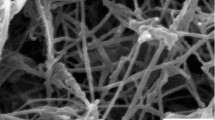Abstract
This paper presents a method for greatly enhancing the electrical conductivity and electromagnetic interference shielding effectiveness of short conducting fiber filled polymers. This method involves the addition of a small proportion of metal particles as a second filler to the fiber polymer-matrix composite. The key to the method is that the metal particles melt during the composite fabrication, so that the metal electrically connects the metal-coated carbon fibers to a certain degree, thereby resulting in a partially connected three-dimensional network. By adding 2 vol% tin-lead particles to 20 vol% short nickel-coated carbon fiber filled polyether sulfone, the electrical resistivity was decreased by a factor of 2000, while the shielding effectiveness at 1 GHz was increased from 19 to 45 dB. No such improvement was found for the same volume fraction of tinlead particles added to an uncoated carbon fiber composite. This difference is due to the superior wetting of solder with nickel compared to that of solder with carbon, as shown by contact angle measurements.
Similar content being viewed by others
References
P. B. Jana and S. K. De, Plast. Rub. & Comp. Proc. & Appl.17, 43 (1992).
P. B. Jana, A. K. Mallick and S. K. De, Composites22, 451 (1991).
Lin Li and D. D. L. Chung, Int. SAMPE Electron. Conf., 4 (Electron. Mater.—Our Future), 777 (1990).
M. S. Ahmad, A. M. Zihilif, E. Martuscelli, G. Ragosta and E. Scafora, Polymer Composites13, 53 (1992).
R. E. Evans, D. E. Hall and B. A. Luxon, SAMPE Q.17, 18 (1986).
Japan Kokai, JP No. 85-83817, May 1985.
J. V. Milewski, Ind. Eng. Chem. Prod. Res. Dev.17, 363 (1978).
A. P. Blythe, Electrical Properties of Polymers, Cambridge University Press, 1980, p. 126.
P. Scheng, Physics Review21, 2180 (1981).
F. J. Balta Calleja, R. K. Bayer and T. A. Ezquerra, J. Mater. Sci.23, 1411 (1988).
S. Radhakrisknan, J. Mater. Sci. Lett.4, 1445 (1985).
K. M. Rails, T. H. Courtney and J. Wulff, Introduction to Materials Science and Engineering, John Wiley and Sons, New York (1976), p. 214.
Lin Li and D. D. L. Chung, Int. SAMPE Electron. Mater. Conf, 6 (Critical Materials and Processes), 121 (1992).
Lin Li and D. D. L. Chung, Composites22, 211 (1991).
Author information
Authors and Affiliations
Additional information
This paper is an extended version of a paper presented at the 6th Int. SAMPE Electron. Mater, and Processes Conf., June 1992.
Rights and permissions
About this article
Cite this article
Li, L., Yih, P. & Chung, D.D.L. Effect of the second filler which melted during composite fabrication on the electrical properties of short fiber polymer-matrix composites. J. Electron. Mater. 21, 1065–1071 (1992). https://doi.org/10.1007/BF02665885
Received:
Issue Date:
DOI: https://doi.org/10.1007/BF02665885




